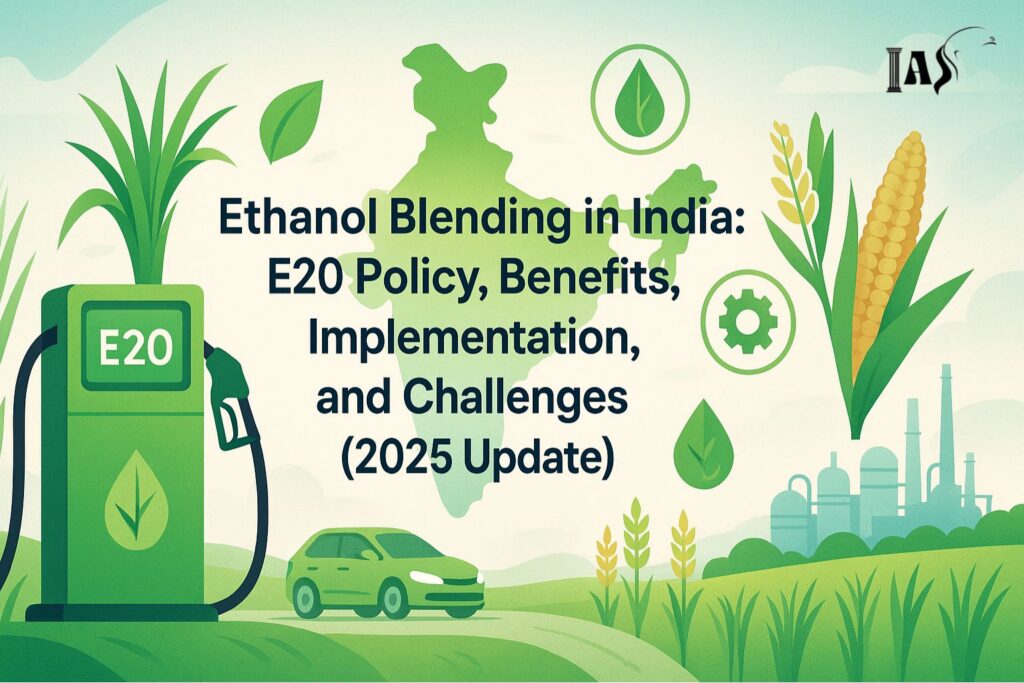Ethanol Blending in India: E20 Policy, Benefits, Implementation, and Challenges (2025 Update)

India has made remarkable progress in its renewable energy journey by achieving 20% ethanol blending
(E20) in petrol — five years ahead of the 2030 target. This success reflects the nation’s strong
commitment to sustainability, energy independence, and environmental protection.
However, this transition also raises important questions about fuel efficiency, agricultural
sustainability, and vehicle performance. Can India maintain this momentum without straining its
natural resources? Let’s explore the E20 Ethanol Policy, its benefits, production process,
challenges, and the path forward for a sustainable future.
Learn how India achieved E20 ethanol blending—explore policy updates, economic & environmental
benefits, and key challenges shaping the country’s green energy future.
What is Ethanol?
Ethanol (C₂H₅OH) is a renewable biofuel derived from the fermentation of plant-based sugars and starches such as sugarcane, maize, wheat, or rice. It is a clean-burning fuel that reduces harmful vehicle emissions and improves combustion efficiency.
With its high octane rating (108.5) and oxygen content, ethanol allows petrol to burn more completely, producing fewer carbon monoxide and hydrocarbon emissions.
How Ethanol is Produced in India
India primarily produces ethanol using two methods — natural fermentation and synthetic production.
1. Natural Fermentation Process
- Feedstock: Sugarcane juice, molasses, broken rice, maize, and other grains.
- Process: Yeast ferments sugars into ethanol and CO₂.
- Benefit: A sustainable, eco-friendly process that promotes agricultural value addition.
2. Synthetic Production
- Derived from petroleum-based ethylene via acid-catalyzed hydration.
- Used as an industrial alternative when natural sources are limited.
This dual approach enables India to maintain a steady ethanol supply while reducing dependency on traditional fossil fuels.
What Is Ethanol Blending?
Learn how India achieved E20 ethanol blending—explore policy updates, economic & environmental benefits, and key challenges shaping the country’s green energy future. Ethanol blending is the process of mixing ethanol, a renewable biofuel, with conventional petrol (gasoline) to create a cleaner and more eco-friendly fuel.
Ethanol is primarily produced from biomass such as sugarcane, maize, rice, or other agricultural residues. By blending ethanol with petrol, India aims to reduce carbon emissions, cut dependence on crude oil imports, and promote energy self-reliance.
Understanding the Aspects of Ethanol Blending
1. Process:
Ethanol acts as an oxygenate, meaning it helps fuel burn more completely in an engine. This improves combustion efficiency, reduces the emission of harmful gases like carbon monoxide, and supports India’s efforts toward cleaner transportation.
2. Nomenclature (Blend Labels):
Ethanol-petrol blends are identified by their ethanol percentage:
- E5: 5% ethanol + 95% petrol
- E10: 10% ethanol + 90% petrol
- E20: 20% ethanol + 80% petrol
These blends are part of India’s Ethanol Blending Programme (EBP), with the government targeting E20 fuel nationwide to promote sustainable mobility.
3. Higher Octane Rating:
Ethanol has an octane number of 108.5, compared to petrol’s 84.4. A higher octane rating means better anti-knock properties, smoother engine performance, and improved fuel efficiency in high-compression modern engines. This is particularly beneficial for vehicles designed to handle ethanol-mixed fuels.
4. Performance Benefits
Ethanol-blended fuels offer several performance and environmental advantages, including:
- Better acceleration and smoother rides
- Lower greenhouse gas (GHG) emissions — up to 30% less CO₂ compared to conventional petrol
Learn how India achieved E20 ethanol blending—explore policy updates, economic & environmental benefits, and key challenges shaping the country’s green energy future.
- Cleaner combustion, leading to improved air quality
- Enhanced energy security by reducing petroleum import dependency

India’s E20 Ethanol Pm olicy: A Vision for Clean Energy
The E20 policy is a crucial component of the National Biofuel Policy (2018), which aims for 20% ethanol blending by 2030. Achieving this target by 2025 demonstrates India’s proactive shift toward energy self-reliance and sustainable mobility.
The policy’s core objectives include:
- Reducing petroleum imports and dependency.
- Enhancing energy security and rural incomes.
- Supporting environmental conservation and green technology growth
- Promoting domestic ethanol production through diversified feedstocks.
Sources of Bioethanol Production in India
1. Primary Feedstock Sources
India has diversified its ethanol production base to ensure supply stability and promote crop diversity.
- Sugarcane Molasses: 220–225 litres per tonne.
- Sugarcane Juice:250–260 litres per tonne during surplus sugar seasons.
- Damaged Food Grains:450–480 litres per tonne.
- Maize and Millets:380–460 litres per tonne, ideal for crop diversification.
Learn how India achieved E20 ethanol blending—explore policy updates, economic & environmental benefits, and key challenges shaping the country’s green energy future.
2. Advanced Feedstock Sources
- 2G (Second-Generation): Agricultural residues like rice straw, wheat straw, corn cobs, and bagasse.
- 3G (Third-Generation):Municipal solid waste and algae.
- Lignocellulosic Biomass: Cane trash, cotton stalks, and corn stover.
This multi-feedstock approach ensures sustainable ethanol production while reducing crop waste and environmental impact.
Key Benefits of Ethanol Blending
Challenges of Ethanol Blending in India
Despite its success, ethanol blending presents several practical and environmental challenges:
- Water Consumption: Approximately 3,000 litres of water required per litre of ethanol
- Soil Health: Intensive sugarcane farming can cause nutrient depletion
- Food vs. Fuel Debate: Using edible grains for ethanol affects food supply
- Fuel Efficiency: E20 can reduce vehicle mileage by up to 7%
- Engine Compatibility: Older engines may suffer corrosion issues
✅ Government Measures to Strengthen Ethanol Implementation
To address these challenges, India is investing in research, infrastructure, and policy frameworks that ensure sustainable ethanol production and use.
- Expansion of Distilleries: Setting up multi-feedstock distilleries across states.
- Commercialization of 2G Technologies: Promoting bio-refineries under PM-JI-VAN Yojana.
- Water Conservation Initiatives: Adopting Zero Liquid Discharge (ZLD) systems.
- Crop Diversification:Encouraging farmers to grow maize and millets instead of sugarcane.
- Tax Incentives: GST reduced from 18% to 5% for ethanol production.
- Vehicle Adaptation:Collaborating with automakers to design E20-compatible engines.
- Supply Chain Optimization:National agencies like NAFED streamline ethanol procurement and distribution.
Way Forward: Toward a Sustainable Ethanol Ecosystem
India’s ethanol mission is a success story in progress — but long-term sustainability requires continuous innovation.
- Pilot E30 trials in public and commercial fleets
- Create price stabilization fund for farmers
- Power distilleries using solar and biomass energy
- International R&D partnerships with Brazil and the U.S.
- Public awareness campaigns about ethanol benefits
- Maintain policy continuity and investor incentives
🎯 Prepare for UPSC with EaseMyPrep
Ethanol blending is a high-relevance UPSC topic under Environment, Economy, and Science & Technology. Stay ahead in your preparation!
📱 Download App 📚 Access Study MaterialConclusion
India’s achievement in reaching 20% ethanol blending ahead of schedule marks a turning point in the nation’s clean energy transformation. Ethanol blending not only reduces emissions and saves foreign exchange but also empowers farmers, strengthens the economy, and creates a cleaner environment.
With continued government support, technological innovation, and public participation, India can become a global leader in sustainable biofuel production — aligning perfectly with its Net Zero by 2070 vision.
Final Note for UPSC Aspirants
Ethanol blending is not just an energy topic — it’s a high-relevance UPSC subject under Environment, Economy, and Science & Technology. Understanding the E20 policy, its benefits, and challenges can give aspirants an edge in Prelims, Mains GS Paper III, and Essay writing.



One Comment
n m